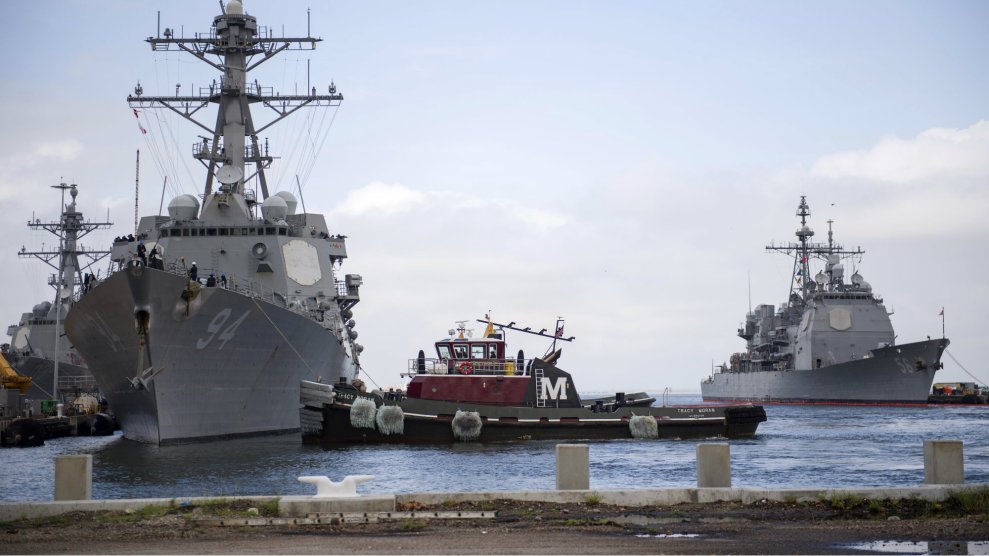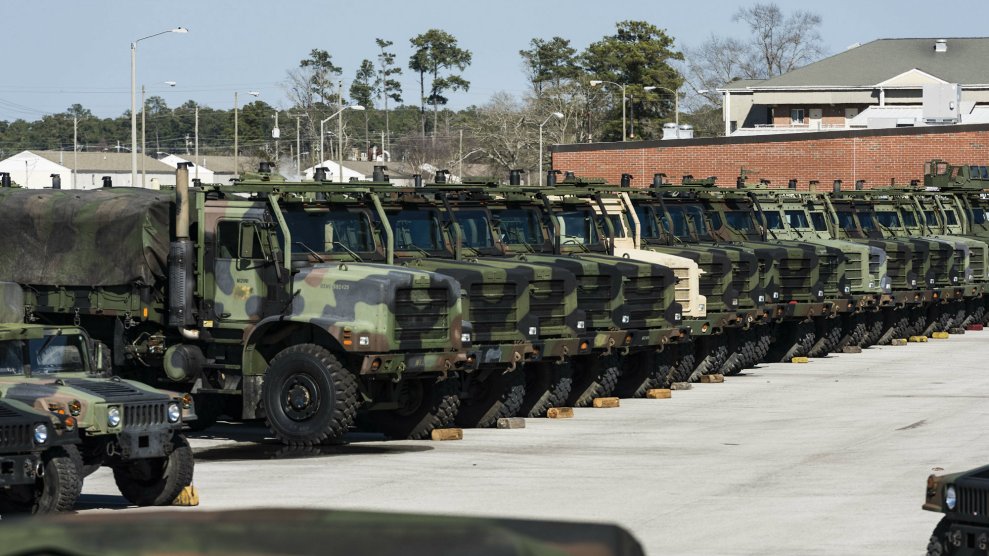
Guided-missile destroyer USS Nitze departs Naval Station Norfolk after the announcement of Hurricane Florence.2nd Class Justin Wolpert/US Navy/AP
One year after President Donald Trump took office, his Defense Department released a survey cataloging the ways climate change has affected thousands of military installations across the globe. Even though Congress had asked the Pentagon to conduct the survey, it was still politically sensitive given the commander-in-chief’s well-publicized views on the subject, which include refusing to acknowledge its existence and expressing contempt for anyone who expects the government to address the problem.
Operating within this hyper-polarized political environment, staffers had quietly scrubbed nearly two dozen references to a warming planet from a draft version of the report. The startling edits, uncovered by the Washington Post weeks after a final report was made public, provided yet another example of how controversial a once-widely acknowledged matter of scientific consensus had become. Climate change was now too toxic a subject for defense officials to emphasize in a report on adapting to climate change.
The selective editing may not be surprising given the political pressure that has infected policymaking around global warming. In some ways, the Pentagon has often been more willing to directly address climate security than other agencies in the Trump administration, including the Interior Department and the Environmental Protection Agency. The Navy has developed a climate “road map,” crafted a strategy for a warmer, more militarized Arctic, and submitted a two-decade, $21 billion plan to Congress that would modernize Navy shipyards across the country, where aging infrastructure is often no match for an increasing number of flooding events. On the other hand, Trump’s new National Defense Strategy, an all-encompassing guide to military and security challenges facing the United States, conspicuously omitted any mention of climate change.
When it comes to the Pentagon, the Republican-majority Senate that consistently opposed Obama-era climate action—and continues to obstruct meaningful environmental regulations—actually incorporated resilience measures into the most recent annual defense spending bill, including a mandate that future military construction projects be a few feet higher if located on a 100-year floodplain. Other surprising line items included $48.4 million additional funds for an energy resilience and conservation initiative and $15.5 million to replace an Alaskan munitions maintenance facility harmed by permafrost thaw. But this may change, because climate skeptic Sen. James Inhofe (R-Okla.), who succeeded John McCain as chair of the Senate Armed Services panel, has already said he does not expect to devote much time to climate policy. “We have more significant things to do with the threats that are out there than to be getting involved in the environmental issues,” he told E&E News in August.
The president can call climate change a hoax and Inhofe can incorrectly say climate goes “through these 30-year cycles,” but defense officials responsible for winning wars and keeping 1.3 million service members safe face grave consequences if they ignore scientific experts. Of the military’s more than 3,500 bases, naval stations, and other installations, 706 reported being affected by flooding, while hundreds more identified disruptions caused by droughts and high winds. Hurricane Florence alone caused roughly $3.6 billion worth of damage to Camp Lejeune, a Marine Corps base in North Carolina. Two months ago, Hurricane Michael devastated the Florida Panhandle and left in its wake catastrophic structural damage to Tyndall Air Force Base. More than a dozen F-22 fighter jets were grounded during the storm. Laura McAndrews, an Air Force spokeswoman, told Mother Jones that the hurricane damaged 95 percent of buildings on the base. Across the country, Naval Base Ventura County in California had to be evacuated due to approaching wildfires.
“Every administration is going to have a different set of priorities,” says John Conger, who previously oversaw energy, installations, and environment as an acting assistant secretary for defense in the Obama administration and now directs the Center for Climate and Security, a Washington research group. “A lot of senior military officials have continued to articulate the view that climate change is real.”
One area where defense officials have long acknowledged the seriousness of climate change is in its national security implications. Even Trump’s Defense Secretary James Mattis has said that climate change has the potential to aggravate security threats. “Climate change is impacting stability in areas of the world where our troops are operating today,” he noted in response to a series of written questions from lawmakers after his confirmation hearing. “It is appropriate for the Combatant Commands to incorporate drivers of instability that impact the security environment in their areas into their planning.”
Heather Babb, a Defense Department spokesperson, said in an email that the agency is “currently reviewing” its climate resilience guidelines “to ensure they support military planning.”
“The department also continues to prudently plan and design facilities to address local weather and environmental conditions and considers resilience in the installation planning and basing processes to include impacts on built and natural infrastructure,” she stated.
The naval shipyard in Portsmouth, Virginia, could prove to be a test case of how far along DoD’s planning can go to prevent climate change from impeding on military readiness. Built in 1767, the shipyard—dubbed “Norfolk,” after the neighboring city—is the largest naval installation in the world. But its location at the southern tip of the Chesapeake Bay has left the Hampton Roads metropolitan area, which includes Norfolk and six other Virginia cities, uniquely vulnerable to extreme weather.
The area has “one of the highest rates of relative sea level rise” along the entire East Coast—about two inches every decade, according to a report conducted by NASA researchers last year. This effect is especially pronounced at the naval base itself, where researchers found that local and federal officials were underestimating how sea level rise was causing the base to sink at a faster rate than the surrounding area. They were not able to pinpoint the reason, but concluded, “If this rate…continues on into the future, the Naval Shipyard would be expected to be [an] ever increasing threat for future sea level rise.“
Climate change is not an abstract or theoretical issue for the thousands of sailors and civilians stationed at Norfolk. In 2009, a devastating leak in one of Norfolk’s five dry docks—combined with an extended period of high tides—led to flooding “at an estimated rate of 3,000 gallons per minute,” a Government Accountability Office report found. Eight years later, four of the shipyard’s dry docks still “face flooding threats from extreme high tides and storm swells.” Two years ago, Hurricane Matthew flooded a human resource building at the base and displaced staffers for six months. “The Navy is actively evaluating flooding concerns at all of its shipyards, with follow-on investments to address concerns,” a Navy spokesperson said in an email. “A military construction project was started in March 2018 at [the Norfolk shipyard] that will upgrade dry dock utility systems and raise equipment out of the flood plain to provide better protection against flooding.”
It might be understandable if naval officials had ignored climate change in the face of more pressing wartime priorities, but that’s not what happened. In April 2010, a 26-page report from a naval task force on climate change frankly acknowledged the threat posed by warming temperatures and rising seas. “Droughts in the southeast and southwest U.S. are challenging water resource management,” the report stated. “Sea level rise and storm surge will lead to an increased likelihood of inundation of coastal infrastructure, and may limit the availability of overseas bases.”
The task force continued producing strategy guidance and collaborating on a report that documented the risk to naval infrastructure from sea level rise. Under the leadership of retired Rear Adm. Jonathan White, who led the group from 2012 to 2015, its members also developed a road map for naval forces in the Arctic region. But despite the level of detail and engagement on the highest levels, the fate of the report resembled that of the federal climate assessment, which Trump dismissed even after a sizable portion of the executive branch produced it. “Tying things to climate change could invite a scrutiny that was undesired,” White told Mother Jones. Ultimately, the Navy’s climate change assessments have driven operational decision making, but not at the pace or magnitude one might have expected. In the other Services, progress has been even slower.
Of the 50 master construction plans reviewed by the GAO after January 2013 across the entire military, only 19 addressed climate change. Officials told the independent government watchdog that planners “were often unaware” of the requirement to plan for the impacts of climate change, despite years of Defense Department reports during the Obama years that mandated this precise action.
“Installations have never been the top planning priority,” says Gordon Adams, who developed military budgets during the Clinton administration and has served in various Pentagon roles. “You have to think 10, 20, 30, and 100 years ahead. And nobody budgets or plans for that.”
Instead of reallocating resources to future-proof their assets, military officials have often resorted to the tried-and-true option of begging Congress for more money. Last year, the Navy submitted a $30 million proposal for a permanent barrier to protect the Norfolk base’s dry docks, part of a $21 billion infrastructure plan, but even that amount of funds could fall short of the cost to secure vulnerable shipyards.
The GAO highlighted one such example in a recent report that identified cost overruns at other naval shipyards. New windows, HVAC, and roof insulation for a single engineering and planning building would cost an estimated $2.5 million, but in order to ensure the fixes complied with a vast and complicated number of regulations—”anti-terror force protection” being one—the price ended up being about $34.7 million, more than 13 times the original estimate.
During the Obama administration, the disconnect between military leaders and the experts who craft climate guidance was vast, but under Trump, the divide has worsened. With a commander-in-chief uninterested in and dismissive of the threat, the military has responded in kind. Social-media accounts related to naval energy, climate, and environmental efforts have all been shut down. The task force on climate change, which the Navy spokesperson says is “still active,” does not appear to have done much recently. Its current website lists the director as Rear Adm. Timothy Gallaudet, who has been acting administrator of the National Oceanic and Atmospheric Administration since October 2017. (The Navy spokesperson said Rear Adm. John Okon now directs the task force.)
The national climate assessment, which extensively detailed the security risks of climate change at home and abroad, landed with a thud across the same executive branch agencies tasked with producing it. EPA acting administrator Andrew Wheeler said he had not read it. Trump said he did not believe it. The Pentagon, which contributed to the assessment, never commented publicly about it.
The best chance for actionable progress remains on Capitol Hill, where lawmakers must somehow come to an agreement on defense spending that clears a Democratic House and secures 60 votes in a bitterly divided Senate. When Congress passed the 2019 defense budget in August, the earliest a Pentagon budget has reached the president’s desk in a decade, Inhofe did not oppose the introduction of a series of amendments geared at sharpening the military’s climate resilience efforts. “Of course, he has a history of being skeptical on climate,” said Conger, the ex-Pentagon official who now directs the Center for Climate and Security. “But each time that we’ve tried to do something in the last couple of years that has been about climate resilience, we haven’t seen strong opposition from him.”
But in those years, the Republicans were led by John McCain, who, mixed environmental record notwithstanding, ushered in an acceptance of climate security that may not outlive him among a caucus that has aligned itself more in the example of Trump. Inhofe has already suggested as much. Earlier this month, he delivered a blistering rebuttal to E&E News of Obama’s environmental legacy at the Pentagon that left no doubt where his priorities stood.
“We ended up using the military to carry out an environmental agenda, which they did, they did successfully, in terms of distractions,” he said. “And so we ended up with billions of dollars in things like the green military and all these things, and we can’t allow that to take place because we have enough problems right now. Right now we’re in the budget fight for the military.”
What programs Inhofe deemed wasteful were not entirely clear—his office did not respond to several requests for comment for this article—but his past statements suggest climate security might rank lower on the chopping block than Obama-era initiatives like the “Great Green Fleet,” which would have used alternative fuel sources to power naval aircraft and ships. Inhofe disparaged the proposal when it was introduced, saying the Pentagon “should not be wasting time perpetrating President Obama’s global warming fantasies or his ongoing war on affordable energy.”

















